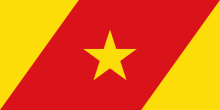Dera, Amhara (woreda)
Dera (Amharic: ደራ) is one of the woredas in the Amhara Region of Ethiopia. Part of the Debub Gondar Zone, Dera is bordered on the south by the Abbay River which separates it from the Mirab Gojjam
Dera ደራ | |
|---|---|
Woreda | |
 Flag | |
| Zone | Debub Gondar |
| Region | Amhara Region |
| Area | |
| • Total | 1,525.24 km2 (588.90 sq mi) |
| Population (2012 est.) | |
| • Total | 270,100 |
Zone, on the west by Lake Tana, on the north by Fogera, on the northeast by Misraq Este, and on the east by Mirab Este. Towns in Dera include Amba Same, Arb Gebeya, Hamusit, and Qorata.
Overview
Points of interest include the Tis Issat falls of the Abbay, and the old Portuguese bridge over the same river at Alata. A survey of the land in this woreda shows that 46% is arable or cultivable, 6% pasture, 1% forest or shrubland, 25% covered with water and the remaining 25.9% is considered degraded or other. Teff, corn, sorghum, cotton and sesame are important cash crops.[2]
The woreda of Dera was heavily affected by the flash floods in Ethiopia that started 6 September and receded by 26 September 2006. The heavy rain caused Lake Tana to overflow its banks, making thousands of people homeless. "Thousands of heads of cattle, whole silos of grain, and significant tracts of grazing and farmland have been washed away," according to IRIN.[3]
Demographics
Based on the 2007 national census conducted by the Central Statistical Agency of Ethiopia (CSA), this woreda has a total population of 248,464, an increase of 17.01% over the 1994 census, of whom 126,961 are men and 121,503 women; 16,772 or 6.75% are urban inhabitants. With an area of 1,525.24 square kilometers, Dera has a population density of 162.90, which is greater than the Zone average of 145.56 persons per square kilometer. A total of 57,237 households were counted in this woreda, resulting in an average of 4.34 persons to a household, and 55,424 housing units. The majority of the inhabitants practiced Ethiopian Orthodox Christianity, with 98.05% reporting that as their religion, while 1.92% of the population said they were Muslim.[4]
The 1994 national census reported a total population for this woreda of 212,341 in 44,156 households, of whom 110,015 were men and 102,326 were women; 12,515 or 5.89% of its population were urban dwellers. The largest ethnic group reported in Dera was the Amhara (99.84%). Amharic was spoken as a first language by 99.94%. The majority of the population practiced Ethiopian Orthodox Christianity with 97.42% professing that belief, and 2.48% of the population said they were Muslim.[5]
Notes
- Geohive: Ethiopia Archived 2012-08-05 at the Wayback Machine
- Ethiopia-Sudan Power Systems Interconnection Project, ESIA Final Report Archived October 11, 2007, at the Wayback Machine, p. 55 (Ethiopian Electric Power Corporation website) This was based on information provided by the woreda in 2006.
- ETHIOPIA:Finding shelter away from flooding; ETHIOPIA:Flood waters receding, both accessed 17 October 2006 (IRIN)
- Census 2007 Tables: Amhara Region Archived November 14, 2010, at the Wayback Machine, Tables 2.1, 2.4, 2.5, 3.1, 3.2 and 3.4.
- 1994 Population and Housing Census of Ethiopia: Results for Amhara Region, Vol. 1, part 1 Archived November 15, 2010, at the Wayback Machine, Tables 2.1, 2.7, 2.10, 2.13, 2.17, Annex II.2 (accessed 9 April 2009)